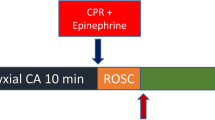Abstract
Reperfusion injury occurs during open-heart surgery after prolonged cardioplegic arrest. Cardiopulmonary bypass also is known to cause hemolysis. Since reperfusion of ischemic myocardium is associated with the generation of oxygen free radicals, and since free radicals can attack a protein molecule, it seems reasonable to assume that hemolysis might be the consequence of free radical attack on hemoglobin protein. The results of this study demonstrated that reperfusion following ischemic arrest caused an increase in free hemoglobin and free heme concentrations, simultaneously releasing free iron and generating hydroxyl radicals. In vitro studies using pure hemoglobin indicated that superoxide anion generated by the action of xanthine oxidase on xanthine could release iron from the heme ring and cause deoxygenation of oxyhemoglobin into ferrihemoglobin. This study further demonstrated that before the release of iron from the heme nucleus, oxyhemoglobin underwent deoxygenation to ferrihemoglobin. The released iron can catalyze the Fenton reaction, leading to the formation of cytotoxic hydroxyl radical (OH·). In fact, the formation of OH. in conjunction with hemolysis occurs during cardiac surgery, and when viewed in the light of the in vitro results, it seems likely that oxygen-derived free radicals may cause hemolysis during cardiopulmonary bypass and simultaneously release iron from the heme ring, which can catalyze the formation of OH·.
Similar content being viewed by others
References
Das DK, Engelman RM: Mechanism of free radical generation in ischemic and reperfused myocardium. In: DK Das and WB Essman (eds.) Oxygen Radicals: Systemic Events and Disease Processes. Basel S. Karger, 1989, pp 97–128
Baker JE, Felix CC, Olinger GN, Kalyanaraman B: Myocardial ischemia and reperfusion: direct evidence for free radical generation by electron spin resonance spectroscopy. Proc Natl Acad Sci USA 85: 2786–2789, 1988
Werns SW, Lucchesi BR: Myocardial ischemia and reperfusion: the role of oxygen radicals in tissue injury. Cardiovasc Drug Ther 2: 761–770, 1989
McCord JM: Oxygen-derived free radicals in postischemic tissue injury. N Engl J Med 312: 159–162, 1985
Ferrari R, Alfieri O, Curello S, et al: Occurrence of oxidative stress during reperfusion of the human heart. Circulation 81: 201–211, 1990
Bagchi D, Das DK, Engelman RM, Prasad MR, Subramanian R: Polymorphonuclear leukocytes as a potential source of free radicals in the ischemic reperfused myocardium. Eur Heart J 11: 800–813, 1990
Kimura Y, Iyengar J, Engelman RM, Das DK: Prevention of myocardial reperfusion injury in experimental coronary revascularization following ischemic arrest by a novel anti-inflammatory drug, ONO-3144. J Cardiovasc Pharmacol 16: 992–999, 1990
Otani H, Engelman RM, Rousou JA, Breyer RH, Das DK: Enhanced prostaglandin synthesis due to phospholipase breakdown in ischemic-reperfused myocardium. J Mol Cell Cardiol 18: 953–961, 1986
Das DK, George A, Liu X, Rao PS: Detection of hydroxyl radicals in the mitochondria of ischemic-reperfused myocardium by trapping with salicylate. Biochem Biophys Res Commun 165: 1004–1009, 1989
Prasad MR, Engelman RM, Jones RM, Das DK: Effects of oxyradicals on oxymyoglobin: deoxygenation, heme removal and iron release. Biochem J 263: 731–736, 1989
Osborn JJ, Cohn K, Hait M, et al: Hemolysis during perfusion. Sources and means of reduction. J Thorac Cardiovasc Surg 43: 459–464, 1962
Rousou JH, Engelman RM, Lemeshow S: Crystalloid cardioplegia-experience with crystalloid potassium cardioplegic solution. In: RM Engelman and S Levitsky (eds.) A Textbook of Clinical Cardioplegia. Futura Publishing Co, 1982, pp 157–176
Buckberg GD, Dyson CW, Emerson RC: Techniques for administering clinical cardioplegia- blood cardioplegia. In: RM Engelman and S Levitsky (eds.) A Textbook of Clinical Cardioplegia. Futura Publishing Co, 1982, pp 305–316
Bolann BJ, Ulvik RJ: Release of iron from ferritin by xanthine oxidase. Biochem J 243: 55–59, 1987
Dilorio EE: Preparation of derivatives of ferrous and ferric hemoglobin. Methods Enzymol 76: 57–72, 1981
Das DK, Cordis GA, Rao PS, George A, Maity S: High performance liquid chromatographic detection of hydroxyl radical in heart. Its possible link with the myocardial reperfusion injury. J Chromatogr 536: 273–282, 1991
Das DK, Engelman RM, George A, Liu X, Rao PS: Mitochondrial generation of hydroxyl radical during reperfusion of ischemic myocardium. In: CC Reddy, GA Hamilton and KM Madyastha (eds.) Proceedings of the International Symposium on Biological Oxidation Systems. Academic Press 11: 999–1010, 1990
Prasad MR, Engelman RM, Clement R, et al: Improved myocardial performance induced by clofibrate during reperfusion after acute myocardial infarction. Can J Pharmacol Physiol 66: 1518–1523, 1988
Wittenberg JB, Wittenberg BA: Preparation of myoglobins. Methods Enzymol 76: 29–43, 1981
Das DK, Engelman RM, Clement R, Otani H, Prasad MR, Rao PS: Role of xanthine oxidase inhibitor as free radical scavenger: a novel mechanism of action of allopurinol and oxypurinol in myocardial salvage. Biochem Biophys Res Commun 148: 314–319, 1987
Steinberg H, Greenwald RA, Sciubba J, Das DK: The effect of oxygen-derived free radicals on pulmonary endothelial cell function in the isolated perused rat lung. Exp Lung Res 3: 163–173, 1982
Yusa K, Shikama K: Oxidation of oxymyoglobin to metmyoglobin with hydrogen peroxide: involvement of ferryl intermediate. Biochemistry 26: 6684–6688, 1987
Stocks J, Dormandy TL: The autoxidation of human red cell lipids induced by hydrogen peroxide. Br J Haematol 20: 95–111, 1971
Boveris A, Chance B: Mitochondrial production of superoxide anion and its relationship to the antimycin insensitive respiration. FEBS Lett 54: 311–314, 1975
Sadrzadeh SMH, Graf E, Patner SS, Hallaway PE, Eaton JW: Hemoglobin. A biologic Fenton reagent. J Biol Chem 259: 14354–14356, 1984
Lohrer RM, Trammer AR, Deitrich W, Hagl S, Linderkamp O: The influence of extracorporeal circulation and hemoseparation on red cell deformability and membrane proteins in coronary artery disease. J Thorac Cardiovasc Surg 99: 735–740, 1990
Lamon EW, Powell TJ, Blackstone EH: Hemolysis after cardiopulmonary bypass. J Thorac Cardiovasc Surg 99: 751–758, 1990
Pruitt KM, Stroud RM, Scott JW: Blood damage in the heartlung machine. Proc Soc Exp Biol Med 137: 714–718, 1971
Author information
Authors and Affiliations
Rights and permissions
About this article
Cite this article
Das, D.K., Engelman, R.M., Liu, X. et al. Oxygen-derived free radicals and hemolysis during open heart surgery. Mol Cell Biochem 111, 77–86 (1992). https://doi.org/10.1007/BF00229577
Issue Date:
DOI: https://doi.org/10.1007/BF00229577




